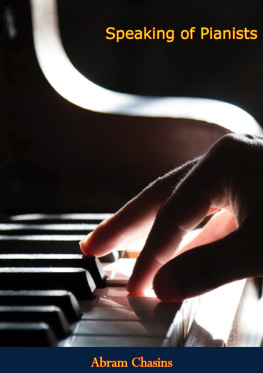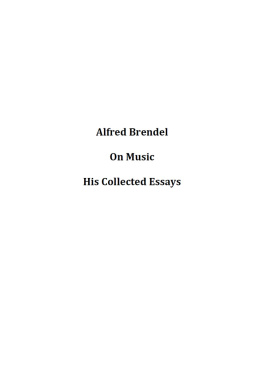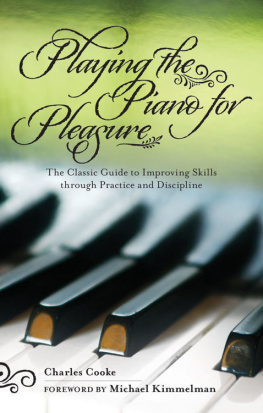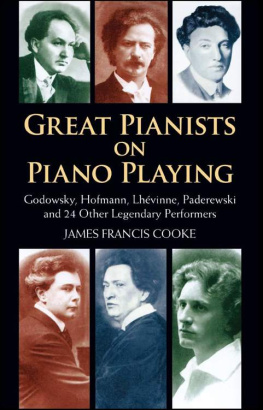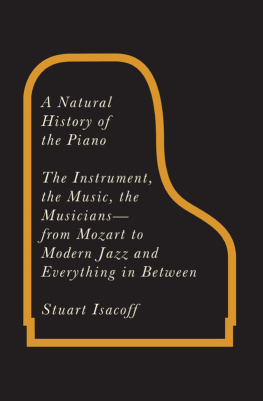
ALSO BY CHARLES ROSEN
Critical Entertainments
MUSIC OLD AND NEW
Romantic Poets, Critics, and Other Madmen
The Classical Style
HAYDN, MOZART, BEETHOVEN
The Romantic Generation
Sonata Forms

To the memory of Hedwig Kanner and Moriz Rosenthal

FREE PRESS
A Division of Simon & Schuster, Inc.
1230 Avenue of the Americas
New York, NY 10020
www.SimonandSchuster.com
Copyright 2002 by Charles Rosen
All rights reserved, including the right of reproduction in whole or in part in any form.
First Free Press trade paperback edition 2004
FREE PRESS and colophon are trademarks of Simon & Schuster, Inc.
For information regarding special discounts for bulk purchases, please contact Simon & Schuster Special Sales: 1-800-456-6798 or business$simonandschuster.com
DESIGNED BY LISA CHOVNICK
Manufactured in the United States of America
1 3 5 7 9 10 8 6 4 2
The Library of Congress has catalogued the hardcover edition as follows:
Rosen, Charles, 1927
Piano notes: the world of the pianist / Charles Rosen.
p. cm.
Includes index.
Contents: Body and mindListening to the sound of the pianoThe instrument and its discontentsConservatories and contestsConcertsRecordingStyles and manners. 1. PianoPerformance. I. Title.
ML 700 .R77 2002
786.2143dc21 2002069634
ISBN 0-7432-0382-8
0-7432-4312-9 (Pbk)
eISBN 978-1-4391-3522-8
ISBN 978-0-7432-4312-4
CONTENTS

PRELUDE

THIS IS A BOOK ABOUT the experience of playing the piano. It is not an autobiography, although I have had to draw on some personal anecdotes, but it concerns the experience of playing relevant to all pianists, amateur as well as professional. What has interested me most of all is the relation of the physical act of playing to those aspects of music generally considered more intellectual, spiritual, and emotional, the different ways that body and spirit interact. I have concentrated mostly on professional experience since I know it best, and also because the amateur ideal today is largely derived from the professional standard, but I write for listeners as well as pianists. I have certainly not attempted to tell pianists how they must play. Although my own prejudices have naturally intruded, I have at least tried to keep them under control. There are many valid approaches to the instrument and to its repertoireand if I occasionally find some approaches invalid, I am not stiff-necked about them, and not wedded permanently to my opinions. I have been most intent on conveying the variety of experience of playing, its torments and its delights.
The temptation is great to write inspirational prose in the grand style about an experience as intense as playing is for any committed pianist. I am embarrassed when I read that kind of prose, however, as the intensity of feeling is only made factitious by being diluted with words, so I have largely preferred to let that intensity be taken for granted. I adore the grand style and I am intrigued by grand synthetic theories, but I am suspicious of teachers who claim to have invented the only successful method for bringing out the best in young performers, of theorists who claim to have invented the unique approach to analysis, and of historians who wish to reduce all the developments of the musical style of the past entirely to the determinism of social conditions. Of course, the place of music in society influences the way we listen and play, but there are so many cases when a composer or pianist produces work badly fitted to the conditions of his or her own time but that turns out for some few contemporaries and then for a later period to be of great value. I have also attempted to discuss the constraints that cause pianists to play in ways to which they are not really committed, and have ventured to speculate briefly on the decisive role the instrument has played in both the history of composition and the reception of music today. Above all, I have tried to become more aware myself of the powerful and peculiar motives that drive some of us to the piano instead of to the violin, the guitar, or the record-player, and of the odd difficulties that this decision creates in our lives.
CHAPTER ONE

BODY AND MIND
ONE OF THE FIRST THINGS a child is taught when learning the piano is to play a C major scale. We always begin with the simple fingering 1 2 3 1 2 3 4 5, and we are shown how to exploit the special character of the human hand and the mobile thumb by crossing the thumb under the third finger as we play the scale; in other scales (E flat for example) we cross the thumb even more awkwardly under the fourth finger. This is a basic part of piano technique as it is conceived in conservatories the world over. Nevertheless, it is a mark of the extraordinary variability of approaches to playing the piano that this fundamental practice is not as useful for some pianists as piano teachers think. A pupil of the late Dinu Lipatti, one of the most interesting pianists of this century, told me that Lipatti once remarked: You know, it has been at least ten years since I last crossed my thumb under the third finger. I was pleased to hear this, because I too have discovered that this basic position is in fact very uncomfortable. Perhaps that is because my thumb is relatively short, not even reaching up to the middle joint of my second finger. I find that wiggling my thumb into an awkward position moves my hand into an inconvenient angle. It is better for me to keep my hand at a steady angle and displace the arm quickly to the right when shifting from the third finger to the thumb, and I have learned how to accomplish this legato. Everything depends, of course, on the shape of the hand, and it must be stressed that there is no type of hand which is more suited to the piano than another. One of the greatest pianists that I ever heardcertainly the most remarkable in his control of the widest possible range and variety of tone colorwas Josef Hoffman, who had a hand so small that he could reach no more than an octave; Steinway built him a special piano in which the ivories were slightly narrower so that he could reach a ninth. His friend Sergei Rachmaninov had a very large hand, as did Rudolf Serkin, and Sviatoslav Richter could not only reach a twelfth but could play the last chord of the Schumann Toccata without arpeggiationan effect which would certainly have astonished the composer. My teacher, Moriz Rosenthal, famous for his technique, had a small hand with stubby fingers; Vladimir Horowitzs fingers were exceptionally long, while Robert Casadesus had fingers so thick that he had trouble fitting them in between the black keys. There is no such thing as an ideal pianists hand.
In addition, there is no agreement on how to hold the hand at the piano: most children are taught to curve their fingers and place the wrist in a middle position, neither too low nor too high, but of course playing rapid octaves generally demands a higher position for wrist and arm. Horowitz played with his fingers stretched flat and Jos Iturbi used to hold his wrist below the level of the keyboard.
Next page



